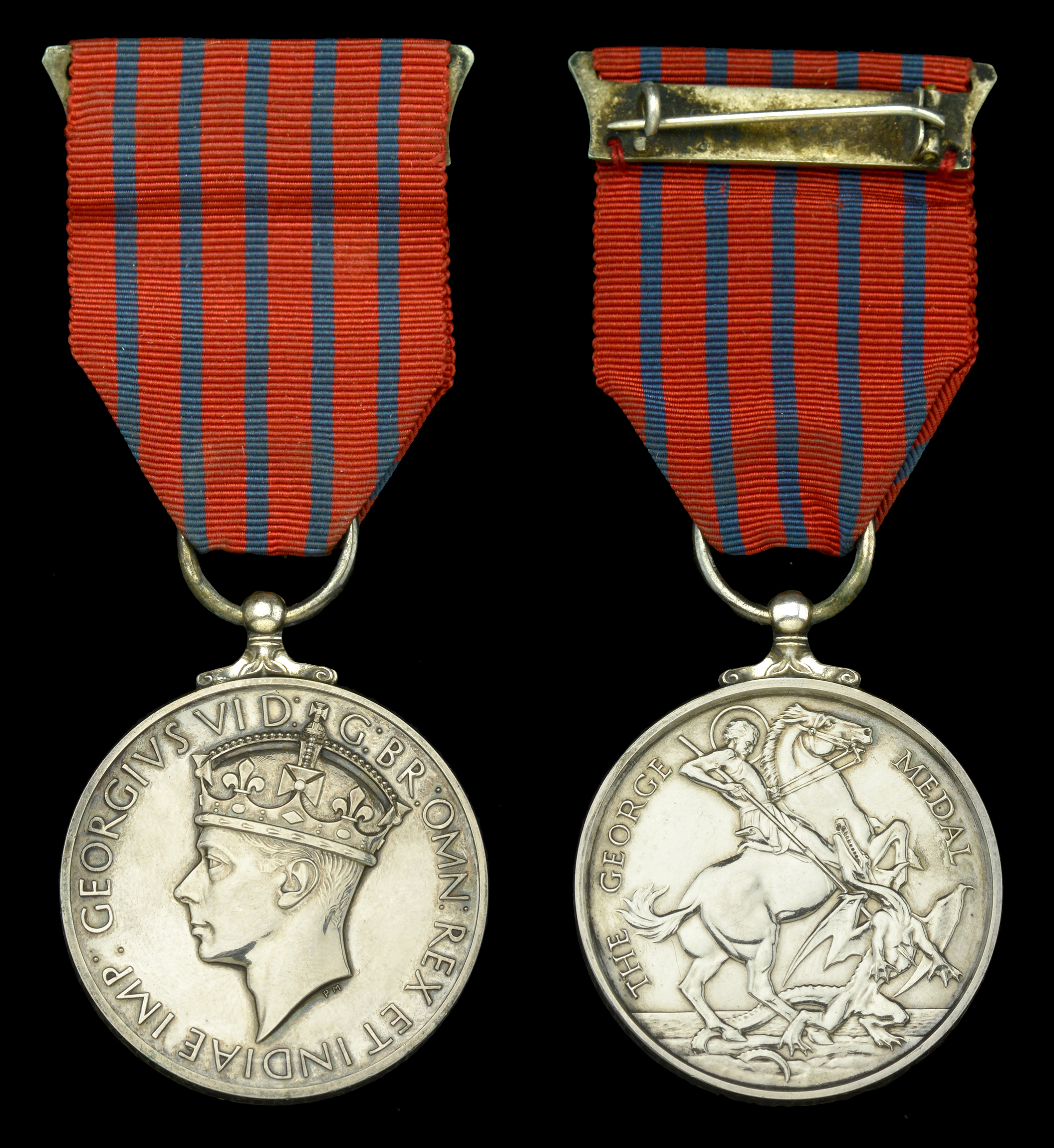The Second War bomb and mine disposal George Medal awarded to Lieutenant S. E. Jenner, Royal Naval Volunteer Reserve, whose gallant work encompassed the Coventry Blitz of November 1940 George Medal, G.VI.R., 1st issue (Elec Lieut Stanley Edmund Jenner, RNVR.) mounted on original investiture pin, nearly extremely fine £2,800-£3,400 --- Importation Duty This lot is subject to importation duty of 5% on the hammer price unless exported outside the UK --- --- Provenance: Penrith Farmers and Kidds, March 2000. G.M. London Gazette 27 June 1941: ‘For gallantry and undaunted devotion to duty,’ The original recommendation states: ‘This officer in November 1940 rendered safe three unexploded enemy mines, two at Coventry and one near the R.A.F. Station, Wythall. One mine, which fell in Humphrey Barton Road, Coventry, called for particular courage and coolness. It first had to be towed out of a hole by rope before it could be dealt with, and this task was made more harassing by an unexploded bomb within 10 yards. During this operation Lieutenant Jenner was ably helped by A.B. Tuckwell, G.C., who showed his usual complete disregard of danger.’ Stanley Edmund Jenner was educated at St. Dunstan’s College, London, and was a playing member of Aldershot Rugby Football Club in the mid-1930s. Commissioned as an Electrical Sub Lieutenant in the Royal Naval Volunteer Reserve in September 1940, he was quickly enrolled as a bomb and mine disposal officer at the shore establishment H.M.S. Lucifer. An account of some of his subsequent ‘incidents’ appeared in the Reader’s Digest in September 1942: ‘The land [parachute] mine is wholly unpredictable. If one fails to explode in the usual 22 seconds, it is impossible to guess when its mechanism may suddenly start. Lieutenant Stanley E. Jenner, for example, once rushed off to deal with a mine which had crashed through two upper stories of a Birmingham flour warehouse and was lying on the sixth floor. “I didn’t like the situation at all,” he told me. “Moving it was out of the question and working on it there meant that I had no chance of escape if it should show signs of going off. “Well, I started to work and in about an hour the mechanism suddenly began ticking – the Nazi rattlesnake’s usual 22-second warning. I fell downstairs in a hurry, expecting next step would find me on my way to Kingdon Come in a cloud of flour. But nothing happened, so after a bit I went back upstairs and found that the ticking had stopped. Thirty minutes later the mechanism went into action once more. Again I moved out in a hurry. “This time, when nothing happened, I sat down and smoked a cigarette. I couldn’t leave the mine there, of course – flour is too valuable in England. So back I went for a third try. When the ticking started again 15 minutes later, I stuck on the job as though nothing was wrong. It stopped again and in two hours the mine was as innocent as a baby.” ’ The recommendation for Jenner’s G.M. refers to two parachute mines that he rendered safe in Coventry in November 1940, most likely after the most devastating Luftwaffe raid of them all on the night of the 14th-15th, when the city was attacked by 500 aircraft. But omitted from the recommendation is the following incident, as also described in The Reader’s Digest: ‘Sometimes a deactivating job can be completed in 30 or 40 minutes. Other mines require four of five hours of nerve-racking effort. In one mine that fell on Coventry, Lieutenant Jenner told me, gadgets were not where he expected to find them; the colour of the wires had been changed; things stuck; the whole internal set up seemed to have been altered – and there he was all alone with it in a vast area of gutted buildings. Suddenly the clock started ticking and Jenner raced towards an underground shelter which he had selected in advance. When the explosion came, he was completely buried but they dug him out unharmed.’ Jenner was advanced to Lieutenant in January 1941 and gazetted for his G.M. in June, but it would not be until May 1943 that he was able to attend an investiture. In the interim, for a subsequent act of gallantry in disposing of a UXB aboard the M.V. Empire Salvage, he was mentioned in despatches (London Gazette 2 September 1941, refers). The UXB may well have been one dropped by the Fleet Air Arm on 15 June 1941, when the ex-Dutch ship was in the service of the Kriegsmarine. She was then boarded and taken as a prize. Sold with his Royal Society of St. George membership certificate, dated 8 October 1941, and an original copy of the above quoted edition of The Reader’s Digest.
Auctioneer's Buyers Premium: 24% (+VAT)
There is an additional charge of 4.95% (+VAT/sales tax)
See Full Terms And Conditions





